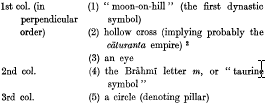No CrossRef data available.
In the course of my lecture on “Some Coins of the Mauryas and Śungas”, delivered before the Royal Asiatic Society in June, 1935, I emphasized two symbols found on the signed coins as being essentially Mauryan, namely, the “moon-on-hill” and the hollow cross. What seems a clinching piece of evidence on the question has since become available to me from the Rāmpurwä copper bolt of Aśoka, now in the Indian Museum, Calcutta, through the kindness of my friend, Mr. Durga Prasad, who examined the bolt and found the marks. A rubbing of these on tissue paper given to him by Mr. N. G. Majumdar, Superintendent in charge of the Archæological Section of the Museum, is reproduced on Plate II. The symbols (written from right to left) are arranged in columns as below (Pl. II (a)):—


page 437 note 1 I may mention here that I have previously suggested that the three arches of the “hill” may be a combination of the Brähmī letters g and tt (gutta, to be read with the sign of candra above). The arches may or may not represent a monogram; but the theory that Candra is meant seems at all events to be sound and beyond controversy, as we have the same crescent (without the arches) on the gold coins of Candragupta I, the Gupta, denoting the same name (Allan, , G.C., p. 9Google Scholar, pl. iii). I am making use of a non-controversial, neutral description: “moon (candra) [placed] on [a] hill.”
page 437 note 2 Cf. the Pāli cāturanta-vijitāvī, an emperor (cakravartin) having empire (country) up to the four ends (i.e. the whole of India). The inscription of Khāravela contains the term in line 1.
page 438 note 1 DrSastri, Hirananda P.T., 6th All-India Oriental Conference, p. 11Google Scholar.
page 438 note 2 Cf. Spooner, D. B., ASR., 1912–1913, p. 78Google Scholar, pl. xlix; Jayaswal, K. P., E.I., xxii, 3Google Scholar, n. Spooner's plate is slightly defective in that it shows only three arrow-mark indicators, instead of four; and the letters thabbha or tha[m]bha at the left-hand corner, maury[y]a (r. to 1.) opposite the “moon-on-hill” symbol, and the ū sign to mū near the figure 3 have not come out clearly.
page 439 note 1 Hultzsch, , Inscriptions of Aśoka, pl. opposite p. 116Google Scholar.
page 439 note 2 Probably the Persian sigloi bearing m in Kharoṣṭhī, (JRAS., 1895, pp. 865, 875Google Scholar; we find there also Brāhmī m and mo, see Nos. 19 and 20) are countermarks of the Mauryas signifying validity (Arihaśāastra, ch. 32; also ch. 26). The rūpadarśaka, who validated coins, was stationed at the treasury (ch. 26), while the lakṣaṇādhyakṣa, the mint-master, had a different office.
page 439 note 3 Taregnā hoard, coin n. 8301, Patna Museum.
page 439 note 4 (a) pottery, 1916 Excavation, No. 10, depth 18 feet (Spooner); (b) pottery, 1923 Excavation, No. 262, depth 17 feet (Ghosh); (c) dagger blade, 1915 Excavation, No. 1, depth 19 ft. 6 in. (Spooner); (d) dagger blade, 1916 Excavation, No. 6, depth 19 feet (Spooner). These details of level are taken from the original excavation records now at the Patna Museum.
page 440 note 1 1927–8 Excavation, No. 51, depth 12 ft. 2 in. (Ghosh).
page 440 note 2 The same lotus mark is found on the Golakhpur, coins (JBRORS. v, p. 72Google Scholar, pi. iv). It may be noted that none of the Golakhpur coins bears any Maurya symbol.
page 440 note 3 Bulandībāgh, cast, copper, No. 231, of 1915–16, depth 21 feet.
page 440 note 4 Chanda, R. P., ASR., 1927–1928, p. 95, pl. xxxvii, fig. 2Google Scholar. The additional symbols are the svastika, so prominent at Jaugaḍa, an elephant facing (that is, on) the standard, and a tree.
page 441 note 1 Stereospermum snaveolens, the Bignonia suaveolens of Roxburgh.
page 441 note 2 Note particularly the pinnate form of the leaves at the end of the lowest branch on the right.